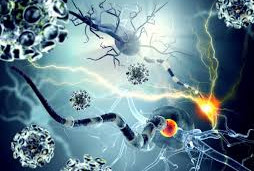What we already knew
The EBV virus is a member of the herpes virus family (oral herpes, genital herpes, chickenpox, shingles, etc.) and is transmitted by droplets of saliva. As a rule, the infection is asymptomatic. In rare cases, the primary infection manifests as glandular fever, viral sore throat and swollen lymph nodes. People who catch glandular fever are three times more likely to develop MS later on. In adulthood, 95% of the population have EBV antibodies, whereas this is the case for almost 100% of MS patients. A particular type of antibody known as anti-EBNA (Epstein-Barr Nuclear Antigen) is present at a higher concentration in MS patients, and this concentration may correlate with the detection by MRI of a greater number of active lesions within the brain. Like all herpes viruses, EBV survives indefinitely in the bodies of all infected people, whether or not they have MS. EBV has a tropism for B cells and it is in those cells that it becomes latent. The presence of the virus or viral proteins in the lymphocytes present in the brains of MS patients is currently disputed, with some studies stating that it is present and others arguing that it is rarely seen and does not directly contribute to demyelinating brain lesions.
What we learn from this new study (published in Science on 13/01/2022)
This study was performed by the team of Professor Alberto Ascherio, an internationally acknowledged specialist in MS epidemiology. Unprecedented in scope, it was carried out over 20 years (1993-2013) using blood samples taken from 10 million young adults working in the US military. These people have their blood drawn every two years to test for HIV (the AIDS virus). The surplus blood samples are stored in a biobank with over 62 million samples. The military population tested comprised 67% men and 33% women. They were young people, 78% being under 26 years of age. Most of the subjects were white (60%) and a significant number black (28%). 5.3% of these individuals were EBV negative at the time of the first blood test. MS was detected in 955 individuals, 801 of whom had had blood samples taken before the onset of the disease. Of these 801 patients, 35 had no EBV antibodies in their first blood sample; 34 tested positive in the second or third sample prior to the onset of their MS. The onset of MS was calculated as occurring on average 7.5 years after the apparition of EBV antibodies in the blood, within a range of 2 to 15 years. Compared with the controls, who always remained EBV negative, the risk of developing MS further to the apparition of EBV antibodies was increased 32-fold. Furthermore, this study showed that blood neurofilament levels were already increasing in the time interval between seroconversion and the onset of the first clinical signs, and NEVER prior to the apparition of anti-EBV antibodies. The increase in neurofilament levels is evidence that the disease is present and taking hold at a low level. Only one MS patient out of 801 remained EBV negative (without detectable antibodies).
To increase the level of certainty, a comparison was made between cytomegalovirus and EBV. Cytomegalovirus is also transmitted by saliva droplets. There was no increase in the risk of MS in people who became positive for cytomegalovirus antibodies, in contrast to what was observed in the case of EBV.
What we don’t yet know
EBV infection is therefore a major factor, necessary although insufficient, in the risk of developing MS, far more so than all other factors already known such as vitamin D deficiency, smoking, obesity, and the susceptibility gene HLA-DR15 (which only increases the risk of MS by a factor of 3). However, we do not as yet know the mechanism(s) by which the EBV virus that has become latent in the B lymphocytes of genetically susceptible individuals triggers the disease. How does the latent presence of this virus disrupt the immune system and cause autoimmunity against brain and myelin antigens? We know that our current treatments destroy or prevent the proliferation of B cells containing this latent virus with partial efficacy on disease progression, but much remains to be done to determine the exact role of EBV. It is possible that the vaccination of children and/or pre-adolescents could prevent EBV infection and thus ultimately prevent the development of MS. This hypothesis could be tested should an EBV vaccine be developed, which as yet is not the case.

